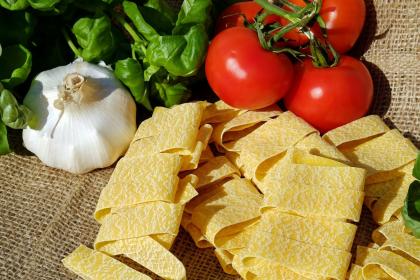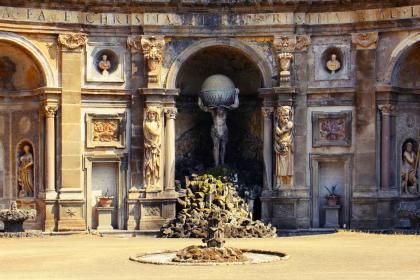
“Portace n’antro litro”, Bring us one more bottle
The light-hearted and bragging spirit of the Roman folk song “La Società dei Magnaccioni”, which was brought to success by the hoarse and scratchy voice of Gabriella Ferri, works as an introduction to the colorful and quite lively world of the Roman “osterie”. Spread since ancient times throughout the whole city and along the consular roads, they are mythical places of the Roman tradition, with a cheerful alcoholic vocation. Yes, because the common thread that runs through their history is of course wine, a staple at the dinner table – where it enhances the flavor of local dishes – but not only. In the city center, a few steps from the Ara Pacis, for example, there is an unexpected homage to one of the many professions related to wine: the small Fountain of the Botticella was built in the 18th century by the Confraternity of Innkeepers and Boatmen of the Port of Ripetta to remember the porters who transported the barrels arrived from the north of Lazio and who practiced the rite of “wine tasting” in front of the church of San Rocco.
All roads lead to Rome
Let’s start by saying that it was with the ancient Romans that the culture of wine reached its first peak and became a profitable business. Famous, in particular, was the Falernian wine coming from northern Campania but the Lazio region produced fine wines such as the Caecuban and Alban wines. The Bellone grape, which is still cultivated today in the province of Rome and Latina, would then derive from an ancient autochthonous variety that Pliny called “pantastica grape”. The fact is that, from being an elite product, wine became an integral component of people’s daily diet for all social classes. Places similar to the osterie already existed in ancient Rome: in the Ostia Antica archaeological park there is a thermopolium dating back to the age of Hadrian, a sort of fast food restaurant where hot food and drinks were served with the inevitable pouring of wine. But a proof of the more than flourishing wine market in ancient Rome is the Monte dei Cocci artificial hill in the Testaccio district, made up of wine and oil amphorae thrown away from the markets of the nearby Emporium. In papal Rome, Testaccio was the privileged destination of the “Ottobrate”, the feasts that closed the month of the grape harvest, washed down with the wine stored in the cellars dug on the slopes of the hill.
“Stai a guarda’ er capello”, You’re looking at the hair
With the fall of the Roman Empire, the monks first kept the winemaking tradition alive, followed by the popes of the Renaissance, whose interest in the subject was partly dictated by the large income ensured by the taxes on wine. The first “sommelier” in history worked at the papal court: Sante Lancerio, bottler to Paul III Farnese, used to select the best wines for the pope, which he then described in a small guide book of the yore. A few years later, in 1588, Pope Sixtus V ordered innkeepers to introduce glass containers for wine, replacing those in terracotta or metal, to avoid fraud. The Tubo (1 liter), the Foglietta (1/2 liter), the Quartino (1/4 liter), the Chirichetto (1/5 liter) and the Sospiro (1/10 liter) became the typical measures of the Roman osterie and the quantity of wine to be respected in each jar was indicated by a line engraved in the glass, called “capello”, hair. So, when the customer complained that the wine was less, the host replied: “You’re looking at the hair”, a saying still used today to invite somebody not to get lost in useless details...
A glass of Frascati wine
Romans truly loved grape vines: until the unification of Italy the city was scattered with an unimaginable number of rows of vines that coexisted with the urban structures, a sign of the unique and extraordinary history of the city. But the true wine of Rome, dry and fresh and with a fruity scent, came from elsewhere, as we are reminded by yet another popular saying: “Vale più un bicchiere de Frascati che tutta l’acqua der Tevere”, a glass of Frascati wine is worth more than all the water of the Tiber. Indeed, the hills of the Castelli Romani have always been an ideal area for the cultivation of vine, both for the soil composition and for the mild climate. The local winemaking tradition had ancient origins but the turning point occurred in 1515, when Prince Marcantonio Colonna granted the city of Frascati a Statute that regulated viticulture, harvesting, processing and sale of local wines. Dating back to the same years are the fraschette (maker-run wine bars), named after the laurel branches and vine shoots they exhibited as a symbol. As a logical consequence, each fraschetta owner then made his own vine pergola providing shade from the sun, where to enjoy a carafe of chilled white.
DOCG and DOC wines
DOCG and DOC are both Italian quality classifications, with DOCG (Denomination of Controlled and Guaranteed Origin) being the highest quality level. The two DOCGs of the province of Rome comes from Frascati: the Frascati Superiore and the slightly sweet Cannellino wine – named after the “Cannella”, the tap of the small container from which it was served – pairing beautifully with Maritozzo, aged Pecorino cheese, or ciambelline al vino (ring-shaped wine cookies). From the same area come two classic DOCs (Denomination of Controlled Origin): Colli Albani and Marino, a white declined in multiple types produced in the delightful medieval villages of Nemi and Rocca di Papa. The DOC wine Bianco Capena also has a long history: ancient Romans called it Feronia, from the name of the Nymph to whom it was offered in religious ceremonies. As regards red grapes, the most important autochthonous vine is Cesanese, at the base of wines of absolute excellence, such as Cesanese di Olevano Romano DOC, Cesanese d'Affile DOC, with a delicate and soft aroma, and Castelli Romani DOC. The most recent DOC is Roma, including red, rosé and white wines as well as sparkling wines developed in the province of Rome.
Traditional cuisine

A journey through the suggestive villages of the Castelli Romani

 Condividi
Condividi
Ciambelline al vino

Biscotti tipici dei Castelli Romani di origine antichissima
Monte dei Cocci

 Condividi
Condividi











































